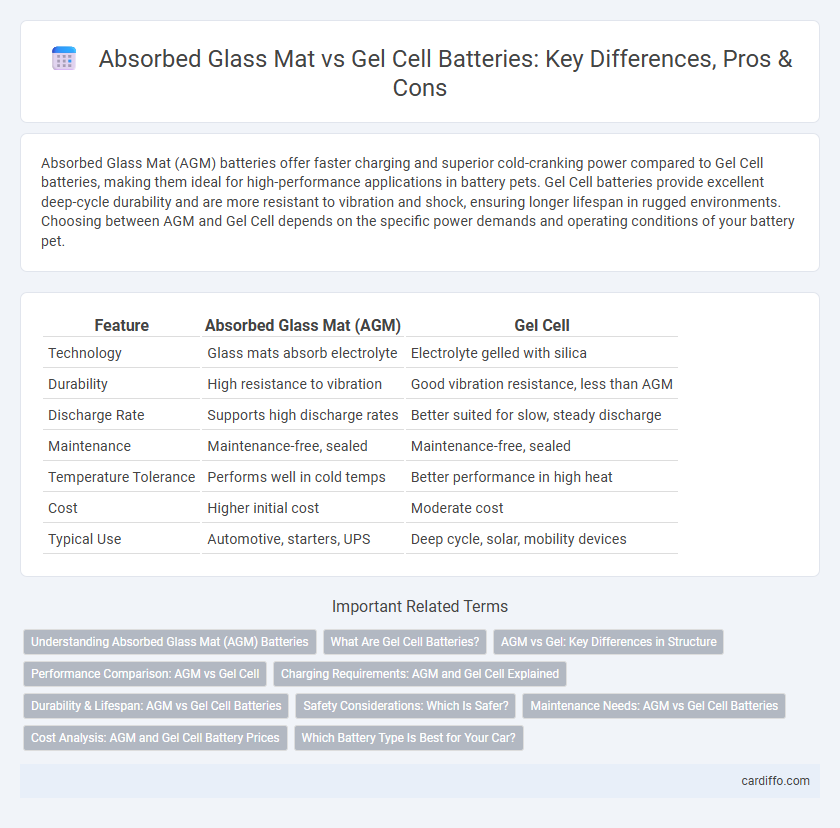Absorbed Glass Mat (AGM) batteries offer faster charging and superior cold-cranking power compared to Gel Cell batteries, making them ideal for high-performance applications in battery pets. Gel Cell batteries provide excellent deep-cycle durability and are more resistant to vibration and shock, ensuring longer lifespan in rugged environments. Choosing between AGM and Gel Cell depends on the specific power demands and operating conditions of your battery pet.
Table of Comparison
| Feature | Absorbed Glass Mat (AGM) | Gel Cell |
|---|---|---|
| Technology | Glass mats absorb electrolyte | Electrolyte gelled with silica |
| Durability | High resistance to vibration | Good vibration resistance, less than AGM |
| Discharge Rate | Supports high discharge rates | Better suited for slow, steady discharge |
| Maintenance | Maintenance-free, sealed | Maintenance-free, sealed |
| Temperature Tolerance | Performs well in cold temps | Better performance in high heat |
| Cost | Higher initial cost | Moderate cost |
| Typical Use | Automotive, starters, UPS | Deep cycle, solar, mobility devices |
Understanding Absorbed Glass Mat (AGM) Batteries
Absorbed Glass Mat (AGM) batteries use a fiberglass mat to absorb the electrolyte, providing spill-proof and maintenance-free operation with enhanced vibration resistance and faster charge acceptance compared to Gel Cell batteries. AGM batteries offer superior performance in high-drain applications and have lower internal resistance, making them ideal for vehicles, marine, and renewable energy systems. Their sealed design minimizes gas release and extends service life, especially in extreme temperature conditions.
What Are Gel Cell Batteries?
Gel cell batteries use a silica-based gel electrolyte that immobilizes the acid, preventing spills and reducing the risk of corrosion. These sealed, maintenance-free batteries excel in deep cycling applications due to their resistance to vibration and temperature extremes. Gel cells offer improved longevity and enhanced safety compared to traditional flooded and absorbed glass mat (AGM) batteries.
AGM vs Gel: Key Differences in Structure
Absorbed Glass Mat (AGM) batteries feature a fiberglass mat separator that absorbs and immobilizes the electrolyte, enabling faster charging and better vibration resistance, while Gel Cell batteries use a silica-based gel to suspend the electrolyte, offering superior deep-cycle performance and better tolerance to extreme temperatures. AGM batteries typically have lower internal resistance and higher cold-cranking amps (CCA), making them ideal for automotive and high-power applications. Gel batteries excel in longevity and safety due to their thicker electrolyte consistency, which minimizes acid stratification and reduces the risk of leakage.
Performance Comparison: AGM vs Gel Cell
Absorbed Glass Mat (AGM) batteries typically offer higher discharge rates and faster recharge times compared to Gel Cell batteries, making them ideal for applications requiring quick bursts of power and frequent cycling. Gel Cell batteries excel in deep cycle performance and provide superior resistance to vibration and extreme temperatures, enhancing durability in harsh environments. Both battery types feature sealed, maintenance-free designs, but AGM technology generally delivers better overall efficiency and power density for performance-critical uses.
Charging Requirements: AGM and Gel Cell Explained
Absorbed Glass Mat (AGM) batteries require a controlled charging voltage typically between 14.4 to 14.7 volts to prevent overcharging and extend battery life. Gel Cell batteries demand a lower and more precise charging voltage around 13.8 to 14.1 volts to avoid damaging the electrolyte gel and ensure optimal performance. Proper charger settings are essential for both AGM and Gel batteries to maintain their longevity and prevent capacity loss.
Durability & Lifespan: AGM vs Gel Cell Batteries
Absorbed Glass Mat (AGM) batteries typically offer superior durability and longer lifespans compared to Gel Cell batteries due to their robust design and enhanced vibration resistance. AGM batteries feature tightly packed glass mats that absorb electrolyte, reducing the risk of leakage and enabling better performance in high-drain applications. Gel Cell batteries, while effective in deep-cycle usage, tend to have a shorter lifespan and lower tolerance to high current loads and extreme temperatures.
Safety Considerations: Which Is Safer?
Absorbed Glass Mat (AGM) batteries offer superior safety due to their sealed design and low gas emissions, reducing the risk of acid leaks and explosions compared to Gel Cell batteries. Gel Cell batteries, while also sealed, contain silica gel electrolyte that can be sensitive to overcharging, potentially causing swelling or venting hazards. AGM batteries typically provide better overcharge tolerance and lower internal resistance, making them a safer choice for high-demand applications.
Maintenance Needs: AGM vs Gel Cell Batteries
Absorbed Glass Mat (AGM) batteries require minimal maintenance due to their sealed design, which prevents electrolyte spillage and eliminates the need for water refilling. Gel cell batteries also feature a sealed construction, but their gelled electrolyte makes them more sensitive to overcharging, necessitating careful voltage regulation to avoid damage. Both AGM and gel cell batteries are low-maintenance options compared to flooded lead-acid batteries, yet AGM batteries generally offer greater ease of use and longer cycle life under typical maintenance conditions.
Cost Analysis: AGM and Gel Cell Battery Prices
Absorbed Glass Mat (AGM) batteries typically cost less than Gel Cell batteries due to simpler manufacturing processes and wider availability of raw materials. Gel Cell batteries often carry a higher price tag because of their advanced electrolyte gel technology, which offers better leak resistance and deep-cycle capabilities for specialized applications. When analyzing cost, AGM batteries provide a more budget-friendly option for general use, while Gel Cells justify their premium price through enhanced durability and performance in extreme conditions.
Which Battery Type Is Best for Your Car?
Absorbed Glass Mat (AGM) batteries offer superior starting power and faster recharge times, making them ideal for modern cars with high electrical demands and start-stop systems. Gel cell batteries provide excellent deep-cycle performance and resistance to vibration, benefiting vehicles that require sustained power over longer periods, such as off-road or recreational vehicles. For typical automotive use, AGM batteries are generally the best choice due to their balance of durability, maintenance-free operation, and high cranking amps.
Absorbed Glass Mat vs Gel Cell Infographic

 cardiffo.com
cardiffo.com